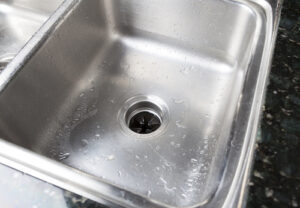
When only the disposer basin in a double-basin sink backs up with water, the drain fitting on the disposer is most likely obstructed.
What Causes a Clog in the Garbage Disposal?
Most food waste can be ground without issue by disposal, however, what happens after the grinding can cause a clog. This is frequently due to how ground food waste responds to water (or lack thereof) after it has been crushed up and sent down the drain line by the disposal machine. When a garbage disposal clogs, the drain trap assembly on the waste discharge side of the disposal is usually the source of the problem.
Disposals can also back up over time as food waste coats the waste pipe or trap, causing it to become clogged. The fault is most likely in the drain trap—the U-shaped plumbing fitting found downstream of the disposal discharge pipe—if your garbage disposal drains slowly or not at all.
The following are some of the most prevalent causes of garbage disposal clogs:
Lack of flushing water: If you don’t push enough water down the disposal while it’s grinding, it’ll clog. Waste can’t be flushed down the pipes if there isn’t enough water, thus it will quickly pile up. Water cannot flow at all after a full blockage has occurred.
Eggshells and coffee grounds should be ground up: Food items such as eggshells and coffee grounds are a bigger concern than you might think. Eggshells and coffee grounds, when pulverized by the disposal, produce very fine granular trash that will attach to any sludge in the pipes and quickly clog them.
Potato peels should not be ground because they are infamous for clogging garbage disposals. They break down into a starchy substance that looks like mashed potatoes and clogs drain quickly.
Banana peels: Banana peels are similar to potato peels in that they contribute stringy fibers to the mix.
What You’ll Need
Equipment / Tools
- Bucket
- Channel-type pliers
- Scrub brush or wire
- Drain snake (if needed)
- Materials
- Paper towels or rags
Instructions
Remove the P-Trap from the equation.
Place a catch bucket beneath the drain trap of the garbage disposal. Disconnect the drain trap’s slip-nut fittings with channel-type pliers, then remove the trap. When you separate the pipes, it’s fairly uncommon for the water to stream out. Water and, most likely, food waste will fill the trap. Dump it carefully into the bucket. Keep paper towels or rags on hand in case of spills.
Get the Trap Clean
Check the trap fitting for clogs or obstructions. Clogs are most commonly found in the trap’s acute bend. The most effective technique to dig out any material is with a little scrub brush. A straightened coat hanger or other wire can also be used.
Examine the Trap Arm
If the clog isn’t in the trap, it could be in the trap arm, which is the horizontal drain piece that connects the trap to the branch drain pipe that leads into the wall. By releasing the slip nut where the trap arm joins the vertical branch drain and dragging the arm out, the trap arm can be removed. Using a brush or wire, clean the inside of the trap arm.
The Branch Drain is Snaked (if Needed)
The clog is most likely in the branch drain leading to the home’s main drain if the P-trap and trap arm were pretty clear when you removed them. The best approach to clean this line is to use a drain snake, also known as an auger. Typically, a simple 25-foot drum auger (available at home centers and hardware stores) will do.
Working the auger cable over pipe bends and breaking up the clog, feed it into the branch drain from under the sink, spinning the drum as you go. To make sure the clog is gone, run the wire out and back through the drain a few times.
Putting the Drain Back Together
Tighten the slide nuts just snugly before reinstalling the trap arm and P-trap. Check the parts’ placements and make sure the trap arm is angled slightly downward toward the branch drain. Tighten the nuts all the way by hand when everything looks good. Tighten them up a little more if necessary with channel-type pliers, but be careful not to overtighten, since this could damage the nuts or threads.
Flush The Drain
To flush any loose debris through the drain system, run water through the disposal for several minutes. When you’re certain the drain is clear, you can do a larger flush by placing a stopper over the disposal opening, filling the sink basin with hot water, then immediately removing the stopper. This clears the pipes and removes any leftover clog material.
Need An Expert
Have a plumbing issue, and need help? Call Top Tier Plumbing and Rooter today and speak to one of our experts who will be happy to help you.

